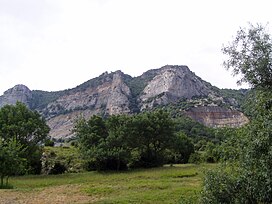| Sierra de Leyre | |
|---|---|
 | |
| Highest point | |
| Elevation | 1,353 m (4,439 ft) |
| Coordinates | 42°38′51″N 1°09′00″W / 42.6475°N 1.15°W |
| Dimensions | |
| Length | 30 km (19 mi) |
| Geography | |
| Location | Spain, Aragon, Navarra |
The Sierra de Leyre[1] or Sierra de Leire[note 1] is a mountain range in Navarre (Spain). It is the first pre-Pyrenean mountain range and is located in the northeast of the Comunidad Foral. It is 30 km long and has an east–west orientation.[2]
It rises above the valley of the Aragón river, above the Berdún channel that collects the waters of the Yesa reservoir. Its most important peaks are Escalar (1302 m.a.s.l.) and Arangoiti (1353 m.a.s.l.) Another notable geographical feature is the Foz de Lumbier, a deep and narrow foz through which the waters of the Irati river flow once it has joined the waters of the Salazar.
On the slopes of Arangoiti is the monastery of Leyre, one of the most important Romanesque monasteries in Navarre, dating from the 8th century, and at the western end is the hermitage of La Trinidad.[3]
Together with the mountain ranges of Urbasa, Andía, Perdón, Alaiz and Izco, it forms a geomorphological and climatic border between Atlantic and Alpine Navarre on the one hand, and Mediterranean Navarre on the other.[4]
The range forms a corridor between Navarre and Aragon, a historical passage used by those who have passed from one kingdom to the other. The Camino de Santiago passes through it, following the Toulouse variant, crossing the Pyrenees at Jaca. The valleys that give access to the Pyrenean mountains, in which the pine has been exploited since ancient times, were formed around the rivers that served as a means of communication and extraction of the wood, which represented the wealth for the community settled in them. These rivers were crossed by the "navateros" or "almadieros" who transported the large logs to the places designated for their transport by land. The construction of the reservoirs, such as Yesa, put an end to this type of transport.[5]
At their feet runs the Cañada Real de los Roncaleses (GR-13), which was the route used by the shepherds of the Roncal Valley and Salazar valley, co-users of the Bardenas Reales, to take their flocks to winter in there. This path starts at the Laza pass, between the Roncal and Salazar valleys, and reaches the hermitage of the Virgen del Yugo, in Arguedas, in the middle of the Bardena, and coincides with the GR-13 long-distance route.
- ^ Ortografía arcaizante, permitida como excepción por la resistencia de los usuarios al cambio (in Spanish). Real Academia Española y Asociación de Academias de la Lengua Española. 2010. p. 626.
- ^ Itxina, Enea; Tellagorri, Mikel (1992). Parajes Naturales de Euskal Herria. Euskal Herriko Natur Parajeak (in Spanish). Bilbao, Vizcaya: España. ISBN 84-87187-63-3.
- ^ Arana Saralegui, Haritz; Bergera Mezquiriz, Pablo (2007). "Sierra de Leyre" (in Spanish). Archived from the original on December 21, 2007. Retrieved November 26, 2007.
- ^ Pejenaute Goñi (2002, p. 23)
- ^ Pascual, Carlos (2006). "Sierra de Leyre, la tierra de San Francisco" (in Spanish). Archived from the original on January 26, 2007. Retrieved November 26, 2007.
Cite error: There are <ref group=note> tags on this page, but the references will not show without a {{reflist|group=note}} template (see the help page).